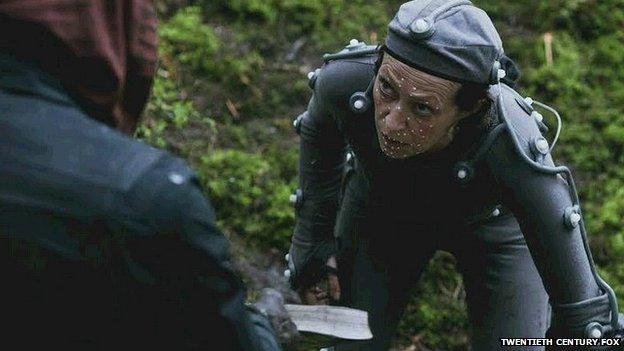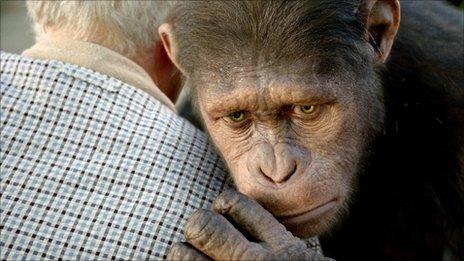How much science is there in new Planet of the Apes film?
- Published

British actor Andy Serkis plays the intelligent chimp Caesar, who is the leader of the ape community
The latest instalment in the Planet of the Apes film franchise opens in the US on Friday. The rubber masks of the 60s and 70s films have been discarded in favour of motion capture suits and CGI. But how much did science inform the new movie's portrayal of our close relatives?
In a career spanning nearly 40 years, Frans de Waal has cemented a reputation as one of the leading authorities on the behaviour of great apes.
The Dutch-born professor at Emory University in Georgia, US, has made a major contribution to our understanding of primate communities - uncovering many parallels with human societies.
But he's not impressed with the way our evolutionary cousins have often been portrayed on screen.
"If they were shown in a respectful way, that would be one thing. But they are usually made to be clowns, which is not helpful for the conservation case or the ethical case," he tells me.
So what did this top primatologist think of the new instalment in the Planet of the Apes franchise?
Dawn of the Planet of the Apes, which goes on release in the US on Friday, is a bold sequel to the 2011 re-boot. That movie - Rise of the Planet of the Apes - saw a group of genetically modified primates revolt against their human masters.

Aggression may be a feature of chimp society, but so is reconciliation
The new film continues the story of that rebellion's instigator, an intelligent chimpanzee by the name of Caesar, but picks up his story after a manmade virus has devastated the human population. Amid the rubble of our civilisation, the apes are pitted against surviving pockets of Homo sapiens in a battle for mastery of the planet.
Prof de Waal calls the storyline "impressive", adding: "I'm not usually into action films like this one, but this held my attention.
"The apes are very humanised: They walk on two legs, they talk - somewhat - they shed tears. In real life, apes do a lot of crying and screaming, but they don't produce tears like we do."
However, other aspects of ape behaviour in the film, he says, are true to life.
"We know chimpanzees are aggressive and territorial - they wage war. The use of tools and weapons is also a possibility," he explains.
To quote a colleague in his field, he said: "If you gave guns to chimps, they would use them."
The primatologist says the reconciliation following a fight between Caesar and Koba - a bonobo character in the film - rang true in terms of ape interactions. He says he also recognised real-life behaviour in a scene where the apes are seen bowing before their appointed leader.
In real groups, Prof de Waal says, "when an alpha male makes an appearance, the other apes grovel and make themselves appear small".

If you gave a gun to a chimp, would they use it?
But he draws attention to the contrast between the thoughtful male chimp Caesar and Koba - a bonobo - who is the most aggressive character in the film.
"It's strange because, in reality, the bonobo is a more peaceful ape than the chimpanzee. There is also the character of an orang-utan, who is interested in teaching and in books, so they have added some twists to it."
Fans will recognise this as an allusion to the position of orangs as a clerical caste in the ape society depicted by the 60s and 70s films and the 1963 novel by French writer Pierre Boule, on which the movies were based.
In real life, orang-utan males are rather solitary, but actress Karin Konoval, who plays the orang Maurice in both Dawn and Rise of the Planet of the Apes, says she understands why the forest primates were characterised as wise elders.
"At core, they are the watchers, who are able to assess everything. They never do anything gratuitously," she told BBC News.
"There is nothing gratuitous that I've ever seen with any of the orang-utans I've known. They are very specific and clear in every choice that they make."
To prepare for the role of Maurice - the trusted confidant of Caesar, played by British actor Andy Serkis - Ms Konoval studied videos of the animals and read "every book that had been written" about the apes.
"The movement of a mature male orang-utan is very specific. So one of the challenges I had on Rise [of the Planet of the Apes] was getting the weight right in my performance. I'm a 120lb woman, and Maurice is a 250lb orang-utan male. One of the things we did in the original film was to weight down my arm stilts," she says.
But she says that being invited to spend time with the five orang-utans at Woodland Park Zoo in Seattle gave her a wealth of experience to bring to her performance in Dawn. Her initial introduction to the group was via a 40-year-old orang male called Tuan, who has something of an artistic streak.

Karin Konoval portrayed Maurice using a motion capture suit
"I watched him paint on a canvas for an hour, an hour-and-a-half at a time. He moves the canvas around and considers it as he goes; this is not slapping the paint around. It was a real artwork. It was amazing," she says.
If the studio were to make another instalment, Prof de Waal says he would advise the filmmakers to include more female and juvenile ape characters, to give a sense of real group dynamics among the animals. In the wild, gorilla and orang males rarely co-operate, as they do in the film, though this is more likely for chimps.
But he praises the film's "astonishing" visual effects, which leads us on to an issue that exercises the professor - the welfare of primates in entertainment.
Prof de Waal strongly opposes the use of real primate actors in advertising, film and television, and comments that Dawn of the Planet of the Apes' realistic depictions of apes using computer technology alone proves that the industry has no need for the genuine article.
"I hope the practice disappears completely," he tells me.
"The first Planet of the Apes movie raised some philosophical issues: What are the ethics of keeping humans in a cage? Which is a reversal of the issue we are faced with now: What are the ethics of keeping an ape in a cage?"
So if apes really did usurp humans as the dominant group on the planet, what does de Waal think it would be like with chimps, bonobos, gorillas and orangs at the top of the pecking order?
"Hmmm," he replies, pausing for a moment. "I'm not an optimist in that regard. The male chimpanzee is very aggressive. I'm not sure they would be angels of peace, as Caesar is in this movie.
"The bonobo would be a more peaceful character - they do not wage war on other groups as chimpanzees do. These groups have even been shown to mingle in the wild on occasion."
"It would be more like Woodstock - and a completely different movie."
Follow Paul on Twitter, external.
- Published11 August 2011
